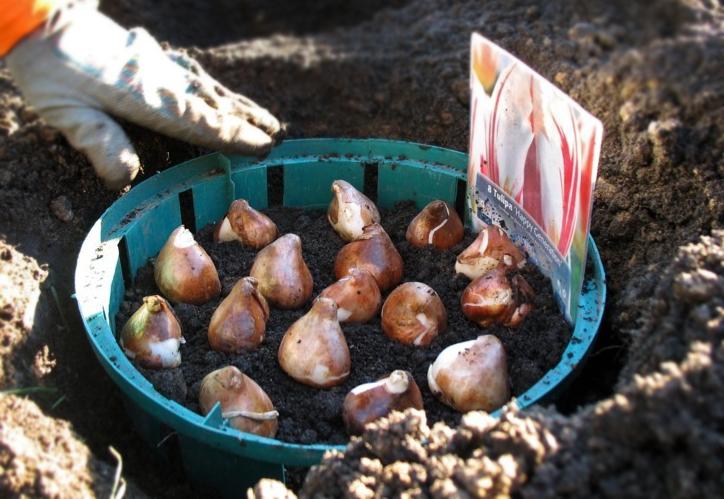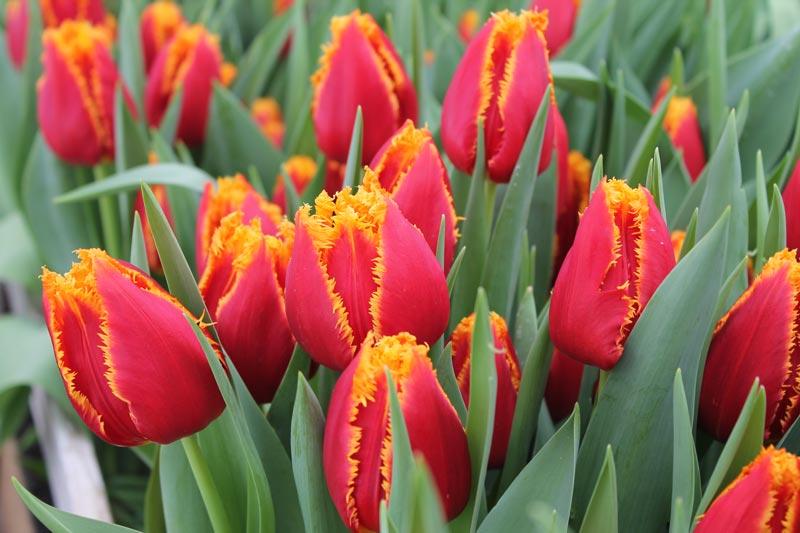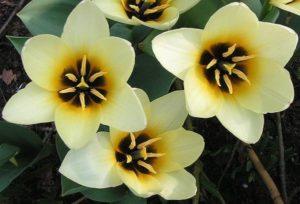When is it better to plant tulips in the fall in the Moscow region
After winter, when all nature is asleep, the first bells of spring appear - tulips. Bright colors of flowers make all living things awaken. A lush bloom in spring is obtained if the bulbs are planted in the ground in autumn. Many inexperienced gardeners are worried about when to plant tulips in the fall in their native Moscow region, in order to have such masterpieces near the house in the spring.
Benefits of autumn planting
Spring planting of tulips may not bloom throughout the season. Therefore, plantings in the autumn win:
- bloom in the first year;
- the bulbs have time to adapt in the open field;
- spring messengers;
- the root system develops well;
- get a supply of moisture and nutrients for flowering.
At the slightest warming, the ground part appears.
When to plant tulips in the fall in the Moscow region?
Tulips need 4 weeks to accumulate strength, develop the root system. It is sometimes difficult to predict the weather for a month. Therefore, the guideline for the timing of landing in the Moscow region is chosen:
- temperature regime of the soil. If at a depth of 10 centimeters the ground has cooled to 6-9 degrees, then this is a signal for an autumn planting. Lower temperatures delay the process;
- planting tulips in the interval: end of September to 20 October;
- "Indian summer". Work at this time will definitely benefit.
If you follow the recommendations, the bulbs will have time to adapt and take root before winter.

Storing tulips before planting
After flowering, the tulip bulbs are dug up and prepared for storage. To do this, perform the following functions:
- cleared of the earth;
- dipped in a weak solution of potassium permanganate for half an hour;
- dried in the shade;
- a week later, the planting material is examined, calibrated, the children and sprouts are separated and dried for some time.
In summer, planting material is stored at a temperature of 20 degrees. Humidity is retained at 70%. In winter, the storage temperature is lowered to 17 degrees - this is in the case of spring planting.
Tulips are folded into boxes and sprinkled with sawdust or wrapped in paper.
The storage place can be a ventilated basement, an insulated balcony, a refrigerator (compartment for vegetables), a heat chamber.

How to do an autumn planting?
On the flower bed, markings should be made so that there are boundaries between the varieties. Small bulbs are planted around the edges of tall crops. All tulips should be exposed to light. A sand cushion, 2 centimeters thick, is poured at the bottom of the site. The loose layer will help the root system to strengthen effortlessly. Planting depth - from 15 to 20 centimeters.The grooves between varieties are left up to 0.5 meters.
Each planting material is laid carefully. Do not allow air spaces under the bulbs. It is undesirable to press in by hand with effort. Such actions will lead to a violation of the bottom of the tubers.
The distance between the rows is 25 centimeters. The top layer is well leveled. Again, do not allow depressions for stagnant water. Plantings are sprinkled with soil mixed with mineral fertilizers and organic matter in the form of humus.

Choosing the location of the flower bed
Tulips prefer sunny, windless places. Flowers do not tolerate stagnant water. When choosing a site, you should pay attention to the depth of the groundwater. It is better to place the flower bed on a hill with good drainage.
Soil preparation
Tulips are planted on fertile soil with a neutral reaction. On such land, the flowers will be large, with a powerful root system.
Any deviations in the composition of the soil from the norm can be easily corrected:
- The acidic soil is diluted with dolomite flour, lime.
- Sand and humus are introduced into heavy soil.
- Light soil is ennobled with sod land, compost, humus.
The soil is prepared 2 weeks before planting. The sites are cleared of previous crops. Fertilizers are added: potassium nitrate, wood ash. Dig a shovel onto the bayonet. Then carefully leveled. There should be no indentations or irregularities on the site.

Herbaceous plants are good predecessors of tulips.
Preparing the bulbs
The planting material is calibrated before planting. For planting, it is better to use coarse bulbs. They root well and give huge buds in spring. Each bulb is visually inspected. Damaged, rotten specimens are removed.
Carefully remove the husk without disturbing the structure of the bulb. Immersed in a growth stimulator before planting.
Planting depth
Depth is of great importance during autumn planting. It depends on how the tulips overwinter. All seasoned gardeners use the golden rule. It states that all bulbous crops are planted 3 diameters of the tuber inward. That is, if the diameter is 5 centimeters, then the depth should be 15, 3 - 9, and so on. There are some deviations from the rules. If the ground is heavy, the depth is reduced by 3 centimeters, on light ground, it is increased by 3.

Bulb planting scheme
Tulip bulbs of a large fraction are planted before winter at a distance of 10 centimeters from each other. Average copies are enough 7. Between the rows, a step of 0.25 meters. This will require 50 bulbs.
Tulips are also planted in a checkerboard pattern - 10x10 centimeters. In this scheme, 100 pieces of planting material are used.
Flower care rules
They take care of tulips from the moment the first shoots appear:
- They inspect the flower bed and identify the cause of the bulbs that have not sprouted. If some specimens are rotten, they are removed from the site.
- Watering is carried out moderately, as the soil dries.
- As soon as the earth dries up after rain or irrigation, loosening is carried out so that oxygen is available to the roots.
- The first feeding is applied when shoots appear. During this period, the plant accumulates green mass, so it needs nitrogen and other trace elements.
- The second feeding is carried out when 3 leaves appear with complex fertilizers.
- The third feeding is needed during the budding period. Potassium and phosphorus are added to the plant.
- The fourth feeding is required in the phase of active flowering - with mineral fertilizers.

All fertilizing is carried out after rain, watering. This will eliminate the possibility of burning the root system. Blooming tulips need to be watered vigorously. For each square meter, at least 2 buckets of water are poured. After a massive bloom, faded buds will appear. During this period, watering does not stop.
With wilted flowers, irrigation is applied for another 2 weeks. The bulbs must accumulate nutrients before they are dug up.
Algorithm of actions after flowering:
- Fallen, wilted petals are removed from the flower bed so as not to allow rot to develop in the leaf axils.
- A week after flowering, the heads of the buds you like are cut off for reproduction.
- The stems are cut off after the leaves turn completely yellow (when the color of the husk is in burgundy blotches), the roots are formed.

The weather is sunny. The roots dry out well.
Preparing for winter
The well-groomed grooves give the tulips a perfect approach to grooming. If there is no rain in the autumn, the tulips are watered.As soon as the first frost is foreseen, the plantings should be mulched. Various materials are used as mulch: straw, fine bark, sawdust, peat. In winter, a layer of snow is poured onto the flower bed.
Tulips sometimes do not survive until spring - they are eaten by rodents. This must be taken care of in advance. It is worth planting "neighbors" that mice are afraid of - daffodils, fritillaria.
Perhaps this will interfere with the conceived composition, then kerosene is used as a protection. All bulbs are placed in a bag and sprayed with a fetid agent. After 30 minutes, a film is formed that is harmless to plants, but scares off rodents.

Other protection measures:
- Vishnevsky ointment". Each tuber is processed.
- Ground red pepper. Mix with soil and place around the tubers.
- From mechanical protection used containers with small cells.
- Metal meshes are made independently. The cells should be 6-7 millimeters long.
- They are planted in a bucket. Only stored in severe frosts in unheated rooms.
Helpful hints
To prevent tulips from getting smaller over time, fulfill some requirements:
- Change your landing site every year.
- Do not violate cultivation techniques.
- Store at the recommended temperature.
- Feed tulips during vegetative growth.









